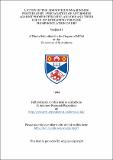A study of the adenovirus DNA-binding protein (DBP) : preparation of antibodies against phosphotyrosine and DBP and their use in investigating tyrosine phosphorylation of DBP
Abstract
It has become clear that protein tyrosine phosphorylation plays a central role in cellular regulation and viral transformation, Adenovirus DNA-binding protein (DBP) is a multi-functional phosphoprotein and a previous study suggested that DBP is phosphorylated at a tyrosine residue (Russell et al, 1989). In order to investigate tyrosine phosphorylation of DBP, attempts were made to prepare polyclonal and monoclonal antibodies against phosphotyrosine (Ptyr) and DBP (adenovirus type2 DNA-binding protein) with success except in the case of the monoclonal antibody (MHb) against Ptyr (Part 1). These antibodies mere used in parallel to detect any Ptyr of DBP in an immunoassay (Part II). Anti- DBP polyclonal antibody was used in immunopreclpitation as well as western blotting and MAb to DBP was used in western blotting and immunofluorescence. Anti-DBP MAb was also used in characterizing the DNR-binding domain of DBP. Polyclonal anti-Ptyr antibody reacted well with phosphotyrosine-containing protein EGFR in immunofluorescence, immunopreclpitation and western blotting but failed to detect Ptyr in DBP in these assays, whereas a synthetic peptide DBPPT195, which consists of a putatide tyrosine phosphorylation site of DBP [aa (amino acid) 1951 and its surrounding residues (aa188-aa201), was shown to be phosphorylated in vitro. In order to obtain an unphosphorylated DBP and mutate the tyrosine (which was suggested to be phosphorylated) of DBP, an attempt to express DBP in E.coli was also made (Part III). The DBP gene was inserted into pGEX-2T vector but the production of fusion protein in E.coli was very poor.
Type
Thesis, MPhil Master of Philosophy
Collections
Items in the St Andrews Research Repository are protected by copyright, with all rights reserved, unless otherwise indicated.

